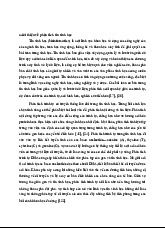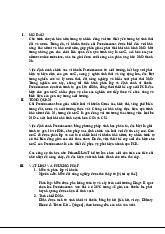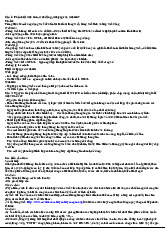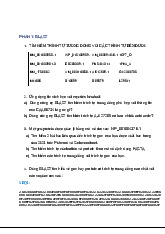




Preview text:
TIN SINH HỌC 1 *
Preparation of Articles for Bioinformatics lab report (2025)
First A. Author, Fellow, IEEE, Second B. Author, and Third C. Author Jr., Member, IEEE Bioengineering K67
Abstract—This document provides a guide for preparing you
r-quick-guide-to-getting-started#. Vp6t pPkrK M9 .
articles for IEEE Transactions, Journals, and Letters. Use
This template is a guide to formatting; your proof and final
this document as a template if you are using Microsoft published version may vary in layout and length to conform to
Word. Otherwise, use this as an instruction set. The electronic
IEEE policy and style. Page count is an estimate; the length of
file of your article will be formatted further at
IEEE. Titles should be written in uppercase and lowercase
your submitted article in the template may not be the same as
letters, not all uppercase. Avoid writing long formulas with
when the formal proof is created by IEEE
subscripts in the title; short formulas that identify the
The IEEE Editorial Style Manual for Authors is available at
elements are fine (e.g., "Nd–Fe–B"). Do not write “(Invited)” https://journals.ieeeauthorcenter.ieee.org/create-your-ieee-
in the title. Full names of authors are preferred in the author journal-article/create-the-text-of-your-article/ieee-editorial-
field but are not required. Put a space between authors’ initials. st
yle-manual/ . This contains a formal set of editorial guidelines
ORCIDs can be provided here as well. In the title, all
variables should appear lightface italic; numbers and units
for IEEE Transactions, Journals, and Letters, including:
will remain bold. Abstracts must be a single paragraph. In
order for an Abstract to be effective when displayed in IEEE ● punctuation;
Xplore as well as through indexing services such as ● capitalization;
Compendex, INSPEC, Medline, ProQuest, and Web of ● abbreviations;
Science, it must be an accurate, stand-alone reflection of the ● section headings;
contents of the article. They shall not contain displayed
mathematical equations, numbered reference citations, nor ● numbers, equations;
footnotes. They should include three or four different ● footnotes;
keywords or phrases, as this will help readers to find it. It is ● biographies;
important to avoid over-repetition of such phrases as this ● some common mistakes;
can result in a page being rejected by search engines. ● units of measurement.
Ensure that your abstract reads well and is grammatically correct.
Communicate your work clearly. If you are not fully
Keywords— Enter keywords or phrases in alphabetical
proficient in English, consider using an English language
order, separated by commas.
editing service before submitting your article. An expert
editing service can help you refine the use of English in your I. TỔNG QUAN
article, so you can communicate your work more effectively.
HIS document is a template for Microsoft Word. If
you would prefer to use LaTeX, download IEEE’s
TLaTeX style and sample files from https://template-
II. VẬT LIỆU VÀ PHƯƠNG PHÁP
selector.ieee.org/secure/templateSelector/publicationType.
When you open the template, select “Page Layout” from the
You can also use the Overleaf editor at htt ps://www.overleaf.
“View” menu in the menu bar (View | Page Layout),
com/blog/278-how-to-use-overleaf-with-ieee-collabratec- (these
instructions assume Microsoft Word. Some versions may have underline.
alternate ways to access the same functionalities noted here).
IEEE will do the final formatting of your article. If your
Then, type over sections of the template or cut and paste from
article is intended for a conference, please observe the
another document and use markup styles. The pull-down style conference page limits.
menu is in the Formatting Toolbar at the top of your Word
This is intended as an authoring template, not a final
window (e.g., the style at this point in the document is
production template. It is not intended to match the final
“Text”). Highlight a section that you want to designate with a
published format. Differences in final formatting are likely in
certain style, and then select the appropriate name on the style
the final IEEE files. Page count in the template is an estimate.
menu. The style will adjust your fonts and line spacing. Do not
Do not adjust line and character spacing to fit your paper to a
change the font sizes or line spacing to squeeze more text into specific length.
a limited number of pages. Use italics for emphasis; do not * TIN SINH HỌC 1
A. Abbreviations and Acronyms
Define abbreviations and acronyms the first time they are
used in the text, even after they have already been defined in
the abstract. Abbreviations such as IEEE, SI, ac, and dc do not
have to be defined. Abbreviations that incorporate periods
should not have spaces: write “C.N.R.S.,” not “C. N. R. S.”
Do not use abbreviations in the title unless they are
unavoidable (for example, “IEEE” in the title of this article).
Use either the Microsoft Equation Editor or the MathType
plugin, which can be obtained from https://store.wiris.com/
en/products/mathtype/download. For help with formatting and
placing equations, refer to the IEEE Editing Math Guide at
http://journals.ieeeauthorcenter.ieee.org/wp-content/uploads/
Fig. 1. This is a sample of a figure caption.
sites/7/Editing-Mathematics.pdf and the IEEE MathType
Tutorial for Microsoft Word Users at http://journals.
ieeeauthorcenter.ieee.org/wp-content/uploads/sites/7/IEEE- TABLE I
Math-Typesetting-Guide-for-MS-Word-Users.pdf.
THIS IS A SAMPLE OF A TABLE TITLE A. Equations
Number equations consecutively with equation numbers in
parentheses flush with the right margin of the column, as in
(1). First use the equation editor to create the equation. Then
select the “Equation” markup style. Press the tab key and write
the equation number in parentheses. To make your equations
more compact, you may use the solidus ( / ), the exp function,
or appropriate exponents. Use parentheses to avoid
ambiguities in denominators. Punctuate equations when they are
B. Multipart Figures part of a sentence, as in B
These are figures compiled of more than one sub-figure p + H 2 = 40. (1)
presented side-by-side or stacked. If a multipart figure is made Be up
sure that the symbols in your equation have been defined
of multiple figure types (one part is line art, and another is before
grayscale or color), the figure should meet the stricter
the equation appears or immediately following. Italicize guidelines.
symbols (T might refer to temperature, but T is the
unit tesla). When referring to an equation or formula, use
simply “(1),” not “Eq. (1)” or “equation (1),” except at the
C. File Formats for Graphics
beginning of a sentence: “Equation (1) is ... .”
Format and save your graphics using a suitable graphics
processing program that will allow you to create the images as
III. KẾT QUẢ VÀ THẢO LUẬN
PostScript (PS), Encapsulated PostScript (.EPS), Tagged A.
Image File Format (.TIFF), Portable Document Format
Types of Graphics
(.PDF), JPEG, or Portable Network Graphics (.PNG). These
The following list outlines the different types of graphics
programs can re-size them and adjust the resolution settings. If
published in IEEE journals. They are categorized based on
you created your source files in one of the following programs
their construction, and use of color / shades of gray:
you will be able to submit the graphics without converting to a
PS, EPS, TIFF, PDF, or PNG file: Microsoft Word, Microsoft
1) Color/Grayscale Figures
PowerPoint, or Microsoft Excel. Though it is not required, it is
Figures that are meant to appear in color, or shades of
strongly recommended that these files be saved in PDF format
black/gray. Such figures may include photographs,
rather than DOC, XLS, or PPT. Doing so will protect your
illustrations, multicolor graphs, and flowcharts.
figures from common font and arrow stroke issues that occur
2) Line Art Figures
when working on the files across multiple platforms. When
Figures that are composed of only black lines and
submitting your final files, your graphics should all be
shapes. These figures should have no shades or half-
submitted individually in one of these formats along with the
tones of gray, only black and white. manuscript. 3) Tables
Data charts which are typically black and white, but sometimes include color.
D. Sizing of Graphics
Most charts, graphs, and tables are one column wide (3.5
inches / 88 mm / 21 picas) or page wide (7.16 inches / 181
millimeters / 43 picas). The maximum depth a graphic can be TIN SINH HỌC 1
is 8.5 inches (216 millimeters / 54 picas). When choosing the
a) Figure axis labels are often a source of confusion.
depth of a graphic, please allow space for a caption. Figures
Use words rather than symbols. As an example, write
can be sized between column and page widths if the author
the quantity “Magnetization” or “Magnetization M,”
chooses, however, it is recommended that figures not be sized
not just “M.” Put units in parentheses. Do not label
less than column width unless when necessary.
axes only with units. For example, write
The final printed size of author photographs is exactly
“Magnetization (A/m)” or “Magnetization (A¿ m−1),”
1 in wide by 1.25 in tall (25.4 mm x 31.75 mm / 6 picas x 7.5
not just “A/m.” Do not label axes with a ratio of
picas). Author photos printed in editorials measure 1.59 in
quantities and units. For example, write
wide by 2 in tall (40 mm x 50 mm / 9.5 picas x 12 picas).
“Temperature (K),” not “Temperature/K.”
b) Multipliers can be especially confusing. Write E.
“Magnetization (kA/m)” or “Magnetization (103 Resolution
A/m).” Do not write “Magnetization (A/m) × 1000”
The proper resolution of your figures will depend on the
because the reader would not know whether the top
type of figure it is as defined in the “Types of Figures”
axis label means 16000 A/m or 0.016 A/m. Figure
section. Author photographs, color, and grayscale figures
labels should be legible, approximately 8- to 10-point
should be at least 300dpi. Line art, including tables should be type. a minimum of 600dpi.
2) Subfigure Labels in Multipart Figures and Tables F. Vector Art
Multipart figures should be combined and labeled before In
final submission. Labels should appear centered
order to preserve the figures’ integrity across multiple computer
below each subfigure in 8-point Times New Roman
platforms, we accept files in the following font formats:
in the format of (a) (b) (c).
.EPS/.PDF/.PS. All fonts must be embedded or text
converted to outlines in order to achieve the best-quality results.
J. Referencing a Figure or Table Within Your Article
When referencing your figures and tables within your article, G. Color Space
use the abbreviation “Fig.” even at the beginning of a sentence. The
Do not abbreviate “Table.” Tables should be
term “color space” refers to the entire sum of colors that can numbered with Roman numerals.
be represented within the said medium. For our purposes,
the three main color spaces are grayscale, RGB
(red/green/blue), and CMYK (cyan/magenta/yellow/black).
L. Color Processing / Printing in IEEE Transactions,
RGB is generally used with on-screen graphics, whereas
Journals, and Letters
CMYK is used for printing purposes.
All IEEE Transactions, Journals, and Letters allow an author
All color figures should be generated in RGB or CMYK
to publish color figures on IEEE Xplore at no charge, and
color space. Grayscale images should be submitted in
automatically convert them to grayscale for print versions. In
grayscale color space. Line art may be provided in grayscale
most journals, figures and tables may alternatively be printed
OR bitmap colorspace. Note that “bitmap colorspace” and
in color if an author chooses to do so. Please note that this
“bitmap file format” are not the same thing. When bitmap
service comes at an extra expense to the author. If you intend
color space is selected, .TIF/.TIFF/.PNG are the recommended
to have print color graphics, you will have the opportunity to file formats.
indicate this in the Author Gateway and will be contacted by
PubOps to confirm the charges. Online-only journals will have
H. Accepted Fonts Within Figures
their figures appear in color, free of charge.
When preparing your graphics, IEEE suggests that you use one IV. KẾT LUẬN
of the following Open Type fonts: Times New Roman,
Helvetica, Arial, Cambria, or Symbol. If you are supplying
A conclusion section is not required. Although a conclusion
EPS, PS, or PDF files, all fonts must be embedded. Some
may review the main points of the article, do not replicate the
fonts may only be native to your operating system; without the
abstract as the conclusion. A conclusion might elaborate on the
fonts embedded, parts of the graphic may be distorted or
importance of the work or suggest applications and extensions. missing.
A safe option when finalizing your figures is to strip out the APPENDIX
fonts before you save the files, creating “outline” type. This
Appendixes, if needed, appear before the acknowledgment.
converts fonts to artwork which will appear uniformly on any screen. TÀI LIỆU THAM KHẢO
I. Using Labels Within Figures
References need not be cited in text. When they are, they
1) Figure Axis Labels
appear on the line, in square brackets, inside the punctuation.
Multiple references are each numbered with separate brackets. TIN SINH HỌC 1
When citing a section in a book, please give the relevant page
[6] H. V. Habi and H. Messer, "Recurrent neural network for rain estimation numbers. using IEEE
In text, refer simply to the reference number. Do not commercial microwave links,"
Trans. Geosci. Remote Sens.,
vol. 59, no. 5, pp. 3672-3681, May 2021. [Online]. Available:
use “Ref.” or “reference” except at the beginning of a
https://ieeexplore.ieee.org/document/9153027
sentence: “Reference [3] shows ... .” Please do not use
automatic endnotes in Word, rather, type the reference list at
Basic format for books:
the end of the paper using the “References” style.
J. K. Author, “Title of chapter in the book,” in Title of Published Book, th x Reference
ed. City of Publisher, (only U.S. State), Country: Abbrev. of Publisher, year,
numbers are set flush left and form a column of ch. x, sec. x, pp. xxx–xxx.
their own, hanging out beyond the body of the reference. The
reference numbers are on the line, enclosed in square brackets. Examples:
In all references, the given name of the author or editor is
[7] G. O. Young, “Synthetic structure of industrial plastics,” in Plastics, 2nd abbreviated
ed., vol. 3, J. Peters, Ed. New York, NY, USA: McGraw-Hill, 1964, pp.
to the initial only and precedes the last name. Use 15–64.
them all; use et al. only if names are not given or if there are [8] W.-K. Chen, Linear Networks and Systems. Belmont, CA, USA:
more than 6 authors. Do not use commas around Jr., Sr., and
Wadsworth, 1993, pp. 123–135. III [9] Philip
in names. Abbreviate conference titles. When citing IEEE
B. Kurland and Ralph Lerner, eds., The Founders’ Constitution.
Chicago, IL, USA: Univ. of Chicago Press, 1987, Accessed on: Feb. 28,
Transactions, provide the issue number, page range, volume
2010, [Online]. Available: http://press-pubs.uchicago.edu/founders/
number, month if available, and year. When referencing a
patent, provide the day and the month of issue, or application.
Basic format for handbooks:
References may not include all information; please obtain and
Name of Manual/Handbook, x ed., Abbrev. Name of Co., City of Co., Abbrev. include
State, Country, year, pp. xxx-xxx.
relevant information. Do not combine references.
There must be only one reference with each number. If there is Examples:
a URL included with the reference, it can be included at the
[10] Transmission Systems for Communications, 3rd ed., Western Electric end of the reference.
Co., Winston-Salem, NC, USA, 1985, pp. 44–60. Other
[11] Motorola Semiconductor Data Manual, Motorola Semiconductor
than books, capitalize only the first word in an article
Products Inc., Phoenix, AZ, USA, 1989.
title, except for proper nouns and element symbols. For
[12] R. J. Hijmans and J. van Etten, “Raster: Geographic analysis and
articles published in translation journals, please give the
modeling with raster data,” R Package Version 2.0-12, Jan. 12, 2012. English
[Online]. Available: http://CRAN.R-project.org/package=raster
citation first, followed by the original foreign-
language citation. See the end of this document for formats
Basic format for reports:
and examples of common references. For a complete
J. K. Author, “Title of report,” Abbrev. Name of Co., City of Co., Abbrev.
discussion of references and their formats, see the IEEE
State, Country, Rep. xxx, year. Editorial Style Manual for Authors at
https://journals.ieeeauthorcenter.ieee.org/create-your-ieee- Example: [13] E.
journal-article/create-the-text-of-your-article/ieee-editorial-
E. Reber, R. L. Michell, and C. J. Carter, “Oxygen absorption in the
earth’s atmosphere,” Aerospace Corp., Los Angeles, CA, USA, Tech. style-manual/.
Rep. TR-0200 (4230-46)-3, Nov. 1988.
Basic format for periodicals:
J. K. Author, “Name of paper,” Abbrev. Title of Periodical, vol. x, no. x, pp.
Basic format for conference proceedings:
xxx-xxx, Abbrev. Month, year, doi: 10.1109.XXX.1234567.
J. K. Author, “Title of paper,” in Abbreviated Name of , Conf. City of Conf.,
Periodicals using article numbers:
Abbrev. State (if given), Country, year, pp. xxxxxx.
J. K. Author, “Name of paper,” Abbrev. Title of Periodical, vol. x, no. x,
Abbrev. Month, year, Art. no. xxxxx, doi: 10.1109.XXX.1234567. Examples:
[14] D. B. Payne and J. R. Stern, “Wavelength-switched passively coupled Examples:
single-mode optical network,” in Proc. IOOC-ECOC, Boston, MA, USA, 1985, pp. 585–590. [1]
J. U. DUNCOMBE, “INFRARED NAVIGATION—
[15] D. Ebehard and E. Voges, “Digital single sideband detection for PART I: AN ASSESSMENT OF ,” FEASIBILITY IEEE
interferometric sensors,” presented at the 2nd Int. Conf. Optical Fiber TRANS. E LECTRON DEVICES, VOL. ED-11, . NO
Sensors, Stuttgart, Germany, Jan. 2-5, 1984. 1,
[16] PROCESS Corporation, Boston, MA, USA. Intranets: Internet PP. 34–39, J . AN 1959, : DOI
technologies deployed behind the firewall for corporate productivity. 10.1109/TED.2016.2628402.
Presented at INET96 Annual Meeting. [Online]. Available: [2] E.
http://home.process.com/Intranets/wp2.htp
P. Wigner, “Theory of traveling-wave optical laser,” Phys. Rev., vol.
134, pp. A635–A646, Dec. 1965.
[3] P. Kopyt et al., Electric “
properties of graphene-based conductive layers
from DC up to terahertz range,” IEEE THz Sci. Technol., to be published,
Basic format for electronic documents (when available
doi: 10.1109/TTHZ.2016.2544142. (Note: If a paper is still to be online):
published, but is available in early access, please follow ref [5]).)
Issuing Organization. (year, month day). Title. [Type of medium]. Available:
[4] R. Fardel, M. Nagel, F. Nuesch, T. Lippert, and A. Wokaun, “Fabrication site/path/file
of organic light emitting diode pixels by laser-assisted forward transfer,”
Appl. Phys. Lett., vol. 91, no. 6, Aug. 2007, Art. no. 061103. [5] D. Example:
Comite and N. Pierdicca, "Decorrelation of the near-specular land scattering
[17] U.S. House. 102nd Congress, 1st Session. (1991, Jan. 11). H. Con. Res.
in bistatic radar systems," IEEE Trans. Geosci. Remote Sens., early
1, Sense of the Congress on Approval of Military Action. [Online].
access, doi: 10.1109/TGRS.2021.3072864. (Note: This format is used
Available: LEXIS Library: GENFED File: BILLS
for articles in early access. The doi must be included.) TIN SINH HỌC 1
Basic format for patents:
singular heading even if you have many acknowledgments.
J. K. Author, “Title of patent,” U.S. Patent x xxx , xxx Abbrev. Month, day,
Avoid expressions such as “One of us (S.B.A.) would like to year.
thank ... .” Instead, write “F. A. Author thanks ... .” In most Example:
cases, sponsor and financial support acknowledgments are
[18] G. Brandli and M. Dick, “Alternating current fed power supply,” U.S.
placed in the unnumbered footnote on the first page, not here.
Patent 4 084 217, Nov. 4, 1978. Basic format for
theses (M.S.) and dissertations (Ph.D.):
First A. Author (Fellow, IEEE) and all
J. K. Author, “Title of thesis,” M.S. thesis, Abbrev. Dept., Abbrev. Univ., City
authors may include biographies if the of Univ., Abbrev. State, year. J.
publication allows. Biographies are
K. Author, “Title of dissertation,” Ph.D. dissertation, Abbrev. Dept.,
Abbrev. Univ., City of Univ., Abbrev. State, year.
often not included in conference-
related papers. Please check the Examples:
Information for Authors to confirm.
[19] J. O. Williams, “Narrow-band analyzer,” Ph.D. dissertation, Dept. Elect.
Author photos should be current,
Eng., Harvard Univ., Cambridge, MA, USA, 1993.
professional images of the head and
[20] N. Kawasaki, “Parametric study of thermal and chemical nonequilibrium
nozzle flow,” M.S. thesis, Dept. Electron. Eng., Osaka Univ., Osaka,
shoulders. The first paragraph may contain a place Japan, 1993.
and/or date of birth (list place, then date). Next, the
author’s educational background is listed. The degrees
Basic format for the most common types of unpublished
should be listed with the type of degree in what field, references:
which institution, city, state, and country, and year the
J. K. Author, private communication, Abbrev. Month, year.
degree was earned. The author’s major field of study
J. K. Author, “Title of paper,” unpublished. J. should be lowercase.
K. Author, “Title of paper,” to be published.
The second paragraph uses the preferred third person Examples:
pronoun (he, she, they, etc.) and not the author’s last
[21] A. Harrison, private communication, May 1995.
name. It lists military and work experience, including
[22] B. Smith, “An approach to graphs of linear forms,” 2014,
summer and fellowship jobs. Job titles are capitalized. arXiv:2105.02824.
The current job must have a location; previous positions
[23] A. Brahms, “Representation error for real numbers in binary computer
arithmetic,” IEEE Computer Group Repository, Paper R-67-85.
may be listed without one. Information concerning
previous publications may be included. The format for
Basic formats for standards:
listing publishers of a book within the biography is: Title
a) Title of Standard, Standard number, date.
of Book (publisher name, year) similar to a reference. b) Title of ,
Standard Standard number, Corporate author, location, date.
Current and previous research interests end the paragraph. Examples:
The third paragraph begins with the author’s
[24] IEEE Criteria for Class IE Electric Systems, IEEE Standard 308, 1969. [25] Letter
preferred title and last name (e.g., Dr. Smith, Prof.
Symbols for Quantities, ANSI Standard Y10.5-1968.
Jones, Mr. Kajor, Ms. Hunter, Mx. Riley). List any
Basic format for datasets:
memberships in professional societies other than the
Author, Date, Year. “Title of Dataset,” distributed by Publisher/Distributor,
IEEE. Finally, list any awards and work for IEEE
http://url.com (or if DOI is used, end with a period) committees and publications. Example:
Second B. Author photograph and biography not
[26] U.S. Department of Health and Human Services, Aug. 2013, “Treatment
available at the time of publication.
Episode Dataset: Discharges (TEDS-D): Concatenated, 2006 to 2009,”
U.S. Department of Health and Human Services, Substance Abuse and
Mental Health Services Administration, Office of Applied Studies, doi:
Third C. Author Jr. (Member, IEEE), photograph and 10.3886/ICPSR30122.v2.
biography not available at the time of publication.
Basic format for code:
Author, Date published or disseminated, Year. “Complete title, including
ed./vers.#,” distributed by Publisher/Distributor, http://url.com (or if DOI is used, end with a period) Example:
[27] T. D’Martin and S. Soares, 2019, “Code for Assessment of Markov
Decision Processes in Long-Term Hydrothermal Scheduling of Single-
Reservoir Systems (Version 1.0),” Code Ocean, doi: _1.24433/CO.7212286.v1 ACKNOWLEDGMENT
The preferred spelling of the word “acknowledgment” in
American English is without an “e” after the “g.” Use the



